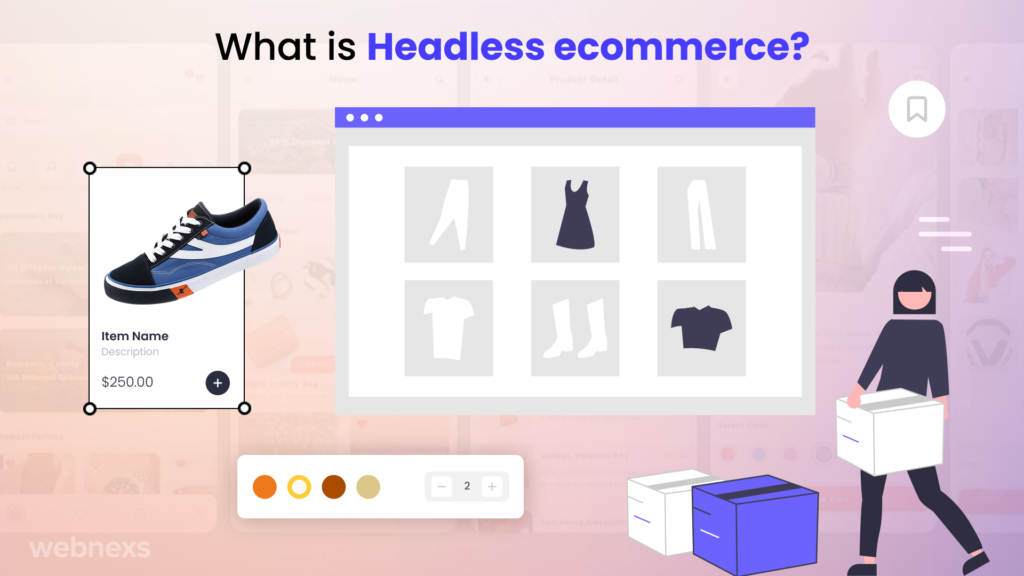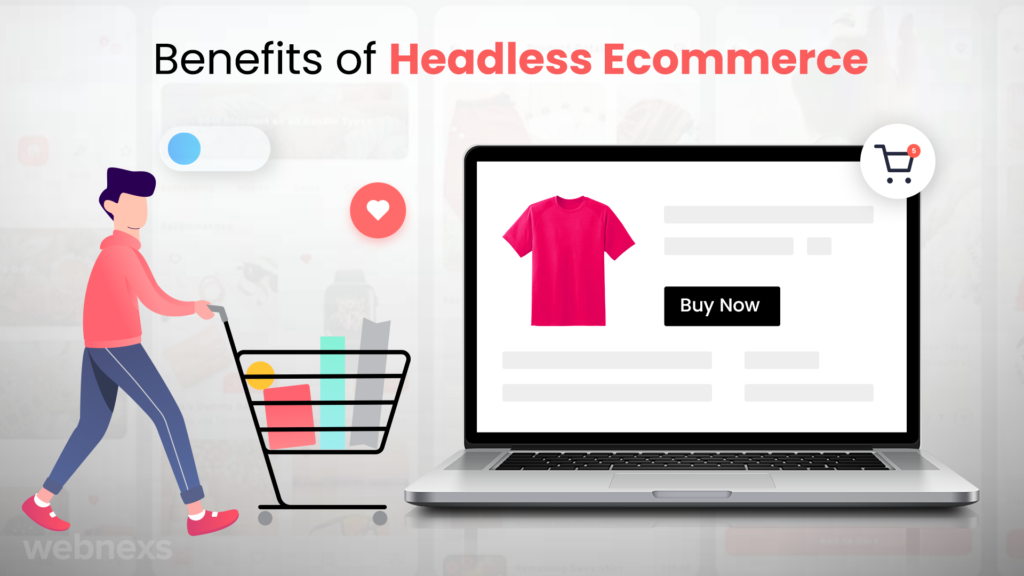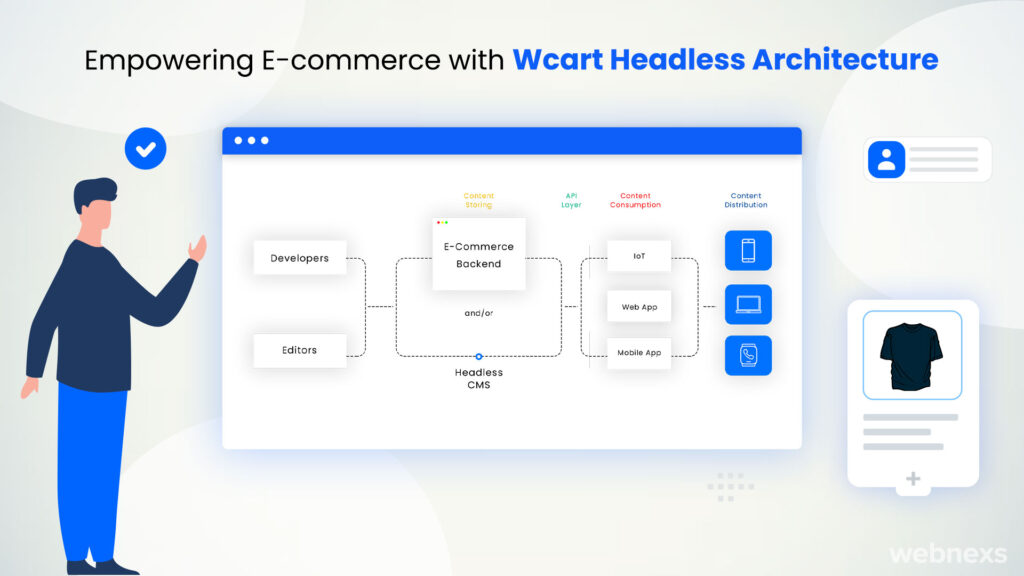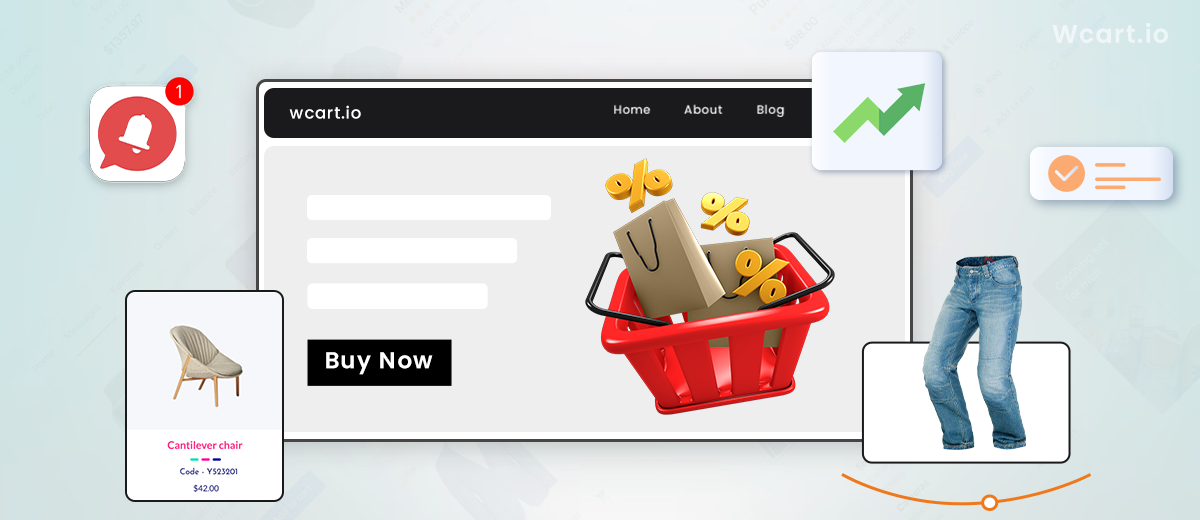Headless e-commerce has emerged as a game-changer in the digital landscape of 2023, revolutionizing the way businesses approach online selling. With its unique architecture and innovative approach, headless ecommerce offers a multitude of benefits that are reshaping the ecommerce industry. In this introduction, we will explore ten key advantages of headless ecommerce, shedding light on why businesses worldwide are embracing this cutting-edge technology to elevate their online shopping experiences. From enhanced flexibility and scalability to improved performance and seamless omnichannel experiences, headless ecommerce is paving the way for a new era of digital commerce. Join us as we delve into the transformative power of headless ecommerce and uncover the myriad benefits it brings to businesses in this dynamic and competitive digital landscape.
Read More: To Know about 10 Challenges Faced by B2B Ecommerce
What is Headless ecommerce?

Headless commerce refers to a modern approach in e-commerce architecture where the front-end presentation layer and the back-end functionality of an online store are decoupled or separated. Unlike traditional e-commerce platforms, which are typically built as monolithic systems, headless commerce allows businesses to have more flexibility and control over their online shopping experiences.
In a headless commerce setup, the front end, which includes the user interface and the customer-facing components like product listings, shopping carts, and checkout processes, is completely detached from the back end, which handles the business logic, data management, and integrations with various systems.
This decoupling is made possible through APIs (Application Programming Interfaces), which serve as the communication channels between the front-end and back-end systems. With this separation, businesses can choose different technologies and frameworks for each layer independently, enabling greater agility and customization.
Overall, headless commerce liberates businesses from the constraints of traditional e-commerce platforms, allowing them to adapt quickly to changing market demands, deliver exceptional user experiences, and optimize their online operations for success.
Read More: To Know Brief About ecommerce Platform
Benefits of Headless Ecommerce

1. Enhanced User Experience:
Headless ecommerce allows businesses to provide superior user experiences across multiple channels and devices. By separating the front-end from the back-end, businesses can optimize website performance, resulting in faster loading times and improved mobile responsiveness. Additionally, the decoupled architecture enables consistent branding and personalization, ensuring a seamless and engaging customer journey.
2. Scalability and Flexibility:
Headless architecture offers scalability advantages for businesses. It can efficiently handle high volumes of traffic, ensuring a smooth user experience even during peak periods. Moreover, headless ecommerce allows for easy integration with additional services, enabling businesses to adapt and expand their offerings as needed. This flexibility future-proofs the e-commerce infrastructure, making it easier to support emerging channels and technologies.
3. Streamlined Content Management:
With headless commerce, businesses can streamline content creation and delivery processes. They can leverage specialized content management systems (CMS) to efficiently manage and personalize website content. This allows for targeted messaging, improved search engine optimization (SEO), and better content optimization, ultimately driving increased visibility and engagement.
4. Streamlined Backend Operations:
Headless commerce simplifies backend development, providing developers with more efficient workflows. With the decoupled architecture, developers can rapidly prototype and deploy changes, resulting in faster time to market. The modular nature of headless architecture also enables easy integration of third-party tools and technologies. Furthermore, centralized data management and analytics capabilities improve operational efficiency, making it easier to track and analyze business performance.
5. Customization and Best-of-Breed Solutions:
Headless commerce empowers businesses to choose the best technologies and tools for each component of their e-commerce ecosystem. This flexibility allows for customization and scalability, enabling businesses to tailor their online experiences to their specific needs. They can integrate specialized solutions, such as content management systems, inventory management systems, and payment gateways, to create a comprehensive and optimized e-commerce infrastructure.
6. Omnichannel Experiences:
By adopting headless commerce, businesses can deliver consistent and personalized experiences across multiple channels. They can seamlessly extend their online presence to various platforms, including websites, mobile apps, social media, and even physical touchpoints. This enables customers to interact with the brand through their preferred channels, fostering a cohesive and engaging omnichannel experience.
7. Increased Speed to Market:
Headless commerce facilitates faster development and deployment cycles. Since the front-end and back-end systems are decoupled, updates and changes can be made independently. This allows businesses to iterate quickly, test new features, and respond to market demands more effectively. By reducing development cycles and increasing agility, headless commerce enables businesses to gain a competitive edge and adapt to changing customer expectations swiftly.
8. Improved Security and Stability:
The separation of the front-end and back-end in headless commerce enhances security and stability. Sensitive data can be isolated in the back-end, reducing the attack surface and mitigating potential risks. Additionally, updates and maintenance can be performed independently on each layer, minimizing downtime and ensuring a stable and secure e-commerce environment.
9. Cost-Effectiveness:
While the initial setup and development of headless commerce may require investment, it can lead to long-term cost savings. By avoiding vendor lock-in, businesses can integrate cost-effective specialized solutions that meet their specific needs. Furthermore, the scalability of headless architecture allows businesses to scale their infrastructure based on actual requirements, optimizing cost efficiency.
10. Future-Proofing:
Headless commerce enables businesses to stay ahead of future technological advancements and market changes. The flexible architecture allows for easy adoption of new channels, such as voice assistants or virtual reality, as well as evolving customer expectations. By embracing headless commerce, businesses can future-proof their e-commerce operations, ensuring long-term relevance and success in a rapidly evolving digital landscape.
Empowering E-commerce with Wcart Headless Architecture

Wcart is a leading e-commerce platform that leverages the power of headless commerce to deliver exceptional online shopping experiences. With its innovative and flexible architecture, Wcart provides businesses with a range of benefits, enabling them to stay ahead in the competitive e-commerce landscape.
→Scalability and Flexibility:
Wcart’s headless architecture offers scalability advantages, allowing businesses to handle high traffic volumes and rapidly adapt to changing market demands. The platform seamlessly integrates with additional services, such as inventory management systems or payment gateways, enabling businesses to scale their operations efficiently and stay ahead of their competitors.
→Streamlined Content Management:
Wcart empowers businesses to manage their content effectively through a specialized headless content management system. With this solution, businesses can create, personalize, and deliver targeted content to their customers, improving SEO, driving engagement, and ultimately increasing their online visibility and revenue.
→Streamlined Backend Operations:
Wcart’s headless commerce approach simplifies backend operations, providing developers with efficient workflows and rapid deployment cycles. The platform’s modular architecture allows easy integration of third-party tools and technologies, enabling businesses to streamline their backend processes and maximize operational efficiency.
→Customization and Best-of-Breed Solutions:
Wcart understands the importance of customization and offers businesses the flexibility to choose the best-of-breed solutions for their specific needs. Whether it’s integrating a powerful inventory management system or a robust analytics tool, Wcart’s headless architecture seamlessly integrates with specialized solutions, empowering businesses to create a tailored and optimized e-commerce ecosystem.
→Omnichannel Experiences:
With Wcart, businesses can deliver consistent and personalized experiences across multiple channels, including websites, mobile apps, and social media platforms. By extending their online presence to various touchpoints, businesses can engage customers wherever they are, ensuring a seamless and cohesive omnichannel experience.
→Increased Speed to Market:
Wcart’s headless commerce approach enables businesses to accelerate their time to market. With independent front-end and back-end development, businesses can iterate quickly, test new features, and respond rapidly to market trends and customer demands. This agility allows businesses using Wcart to gain a competitive edge and capitalize on emerging opportunities swiftly.
→Improved Security and Stability:
Wcart places a strong emphasis on security and stability. With its headless architecture, sensitive customer data is safeguarded in the back-end, reducing potential security risks. The platform also ensures stability by allowing independent updates and maintenance on the front-end and back-end layers, minimizing downtime and ensuring a secure e-commerce environment.
Wcart exemplifies the power of headless commerce in transforming e-commerce operations. With its emphasis on enhanced user experiences, scalability, customization, and streamlined operations, Wcart empowers businesses to thrive in the dynamic world of online retail. By embracing Wcart’s headless architecture, businesses can unlock their full potential and drive online success like never before.
Conclusion
In conclusion, headless e-commerce offers a range of benefits that can revolutionize online businesses. By decoupling the front-end presentation layer from the back-end infrastructure, businesses can enhance user experiences, scale their operations, streamline content management, and optimize backend processes. The flexibility of headless architecture allows for customization and integration of best-of-breed solutions, while omnichannel capabilities enable consistent experiences across various channels. Headless commerce also facilitates increased speed to market, improved security and stability, and long-term cost savings. By embracing headless ecommerce, businesses can future-proof their operations and power their online success to new heights.
Frequently Asked Questions(FAQs)
What is headless ecommerce and how does it differ from traditional ecommerce?
Headless ecommerce is an architecture where the front-end (presentation layer) and backend (commerce engine) are decoupled. In traditional ecommerce, the front-end and back-end are tightly coupled, meaning any changes to the front end require modifications to the backend. Headless commerce separates the two, allowing for independent development and flexibility in delivering content across multiple channels.
What are the benefits of headless ecommerce?
Headless ecommerce offers several advantages, including:
a. Flexibility
b. Personalization
c. Scalability
d. Faster time-to-market
e. Integration capabilities
Is headless ecommerce suitable for all businesses?
Headless ecommerce is particularly beneficial for businesses that require a high degree of flexibility, personalized customer experiences, and the ability to deliver content across multiple channels. It is especially useful for larger enterprises with complex requirements, omnichannel strategies, or those seeking to differentiate their brand through unique customer experiences.
Are there any challenges associated with headless ecommerce?
While headless ecommerce provides numerous benefits, it’s important to consider potential challenges, such as:
a. Technical expertise
b. Increased complexity
c. Cost considerations
Can existing ecommerce platforms be transformed into a headless architecture?
In many cases, existing ecommerce platforms can be transformed into a headless architecture. However, the process may vary depending on the platform’s architecture and capabilities. Some platforms may offer headless features or extensions that allow for decoupled front-end development.




Leave a Reply